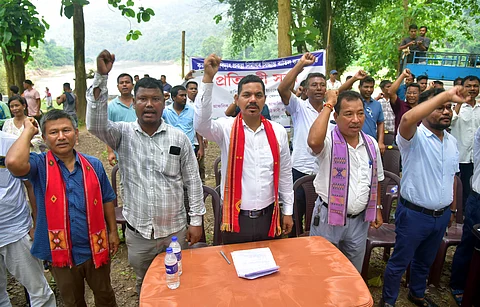
- Home
- Live Blog
- Breaking News
- Top Headlines
- Cities
- NE News
- Sentinel Media
- Sports
- Education
- Jobs

A CORRESPONDENT
BOKO: Several organizations of South Kamrup area including All Rabha Students’ Union (ARSU), Assam-Meghalaya Joint Protection Committee/ Ukium-kyrsai, Garo National Council/ Assam Zone, All Rabha Women Council (ARWC), All Rabha National Council (ARNC), Garo National Council (GNC), Garo Students Union (GSU), and others along with more than two thousand people took out a protest rally on Wednesday on National Highway 17 at Chaygaon against the proposed hydroelectric project on Kulsi river. Later, they submitted a memorandum to the Assam Chief Minister through the Chaygaon Revenue Circle Officer.
The ARSU Vice-President said that the 55 MW hydropower project was proposed to be constructed on the Kulsi river on the Assam-Meghalaya border after bilateral talks between Assam Chief Minister Himanta Biswa Sharma and Meghalaya Chief Minister Conrad Sangma at a guest house in Koinadhora at Guwahati on June 2. “However, after learning about this decision, people of the area along with many organizations had organized a protest meeting at Ukiam near the proposed project area of Kulsi Hydropower Project on June 9 and after a threadbare discussion about the proposed project, the said protest public meeting condemned the venture,” said Pradip Rabha.
The organizations submitted a memorandum to the Assam Chief Minister, Himanta Biswa Sarma, where they wrote extensively about the problems that would arise if the dam was built. According to the memorandum, if the proposed 55 MW Kulsi Hydropower project was installed at Ukiam, then the natural flow of Kulsi river would be affected or blocked which would in turn affect the natural vegetation and crops throughout the South Kamrup district from Ukiam to Nagarbera. Moreover, in the rainy season, if the phenomenon of cloudburst is caused or due to heavy rainfall, if it was not possible to hold more water in the reservoir of the dam, the sudden release of water would cause havoc and devastation on a large scale downstream, and lives of people and domestic animals along with assets would be lost, stated the memorandum. Thus, the organizations vehemently opposed the installation of the Kulsi Hydropower project and demanded its immediate cancellation.
The memorandum also stated that the Chandubi wetland was located within a range of 3 km from the proposed Kulsi hydropower dam which would be 62 meters in height as per the proposal. It argued that the reserved water of the proposed dam would be like a water-bomb for the downstream of Kulsi river and human habitat and if any massive earthquake occured again in this area, there was a danger of the dam collapsing and devastating the Chandubi wetland and its adjacent area.
The Kulsi River is also the natural habitat of the endangered species of Gangetic river Dolphin (Platanista Gangetica) locally known as ‘Sihu’. It is enlisted in the IUCN Red List and declared by the Government of Assam as the State Aquatic Animal in 2009 and also as National Aquatic Animal by the Government of India in 2010. The protesters said that the proposed hydropower project would put the mentioned dolphin and other aquatic life at risk.
Suneet P Marak, President of GNC, pointed out the difficulties and problems which would arise in attempting to relocate the villagers in the vicinity of the dam site. The organizations said that they will continue their protest until the project is cancelled by the both state governments.
Also Read: Assam: ONGC clears path for final snubbing operation at RDS 147A
Also Watch: